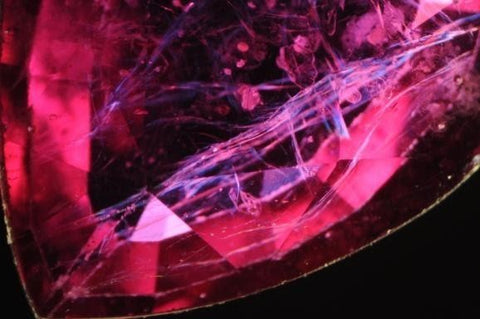Imitations, Substitutes and Treatments Of Stones And Gems: The Trap to Avoid
As the market for gems, jewelry and fine jewelry has gone global, treatments are evolving ever faster and harder to pin down.

Every day we are solicited by a rigorous and demanding clientele who find themselves confronted with substitutes or imitations of stones. Not to mention that the market, in a few decades, will be flooded with laboratory diamonds.
My diploma in gemmology allows me to come into contact with imitation stones on a daily basis. Here is a summary of the different types of stones that can replace natural stones:
Imitations:
Imitations have a similar appearance to imitation stone. They have few or no physical, chemical or optical characteristics in common.
There have been many substitutes for gemstones since ancient times, such as glass, which the Egyptians were the first to produce.
Today rhinestones, that is to say lead glass, is still relevant to imitate diamonds, lead allowing the glass to shine.
Many other diamond imitations are widely available in the market. I will mention some artificial crystals which have physical and optical characteristics in common with diamond: synthetic strontium titanate, YAG (Yttrium Aluminum Garnet), GGG (Gadolinate Gallium Garnet), linobat and synthetic zirconium oxide which particularly floods the market.
We must not forget a more recent imitation that is synthetic moissanite marketed since 1997. This stone has a hardness, a luster, a thermal conductivity close to diamond. The thermo conductivity meter and the reflectometer are unable to tell the difference between a diamond and a moissanite.

Doublets:
Doublets are so-called "assembled" stones.
There is the DGV (Doublet Garnet-Glass) which is a stone made up of a piece of glass and a strip of Almandine garnet. We can also cite the Doublet Enamel made up of two pieces of rock crystal, synthetic spinel or beryl and between the two at the level of the lamination a strip of enamel.

The Fine Corundum-Synthetic Corundum Doublet also exists, it consists, as its name suggests, of two stones: one natural and one synthetic. These stones are often very broken.
Synthetic stones:
Synthetic stones are produced in the laboratory having almost the same physical, chemical and optical properties as natural stones.
For emeralds there are mainly anhydrous synthetic emerald and hydrothermal synthetic emerald. To identify the hydrothermal emerald, only the binocular can make the diagnosis.
The corundum family including rubies, sapphires, colored sapphires is also the target of many syntheses: Verneuil synthetic corundum, anhydrous synthetic corundum, hydrothermal synthetic corundum, Czochralski synthetic corundum (draw method) and more many others. Verneuil synthetic corundums are particularly used and mounted on many jewels and even very old jewels since they were industrialized from 1902. Its principle is as follows: An alumina powder mixed with a coloring product is heated to 2000°C in an oven.
The drop formed when it comes out of the torch falls on a small base on which is placed a crystallization seed where it crystallizes and gradually forms a bottle-shaped volume.
Very large stones can be cut in these Verneuil synthetic rough. This synthesis even makes it possible to make star sapphires or rubies!

Verneuil synthesis is also used to make synthetic spinel.
Synthetic rutile, also called titania, is used to replace diamond, it has been marketed since 1948. However, its dispersion is 6 times greater than that of diamond.
The industrial synthesis of diamond was successful in 1953-1954 in the United States and Sweden.
In recent years, between newspapers and radio shows, everyone has heard of synthetic diamonds also called laboratory diamonds or "lab grown". Unfortunately currently, only gemological laboratories such as the LFG, GIA or HRD are able to authenticate a synthetic diamond. This remains a huge problem for our profession as the profusion of synthetic diamonds used as pavé in jewelry making will soon be impossible to detect with our tools and magnifying glasses.
Today practically all gems have a corresponding synthesis that can be marketed.
The profession authorizes the marketing of synthetic gems, there is even a market and a demand. On the other hand, the certificate issued by the trader must mention that the stone is a synthesis as well as the treatments which must be specified on the invoice.
The reconstituted gems:
Reconstituted gems are materials obtained from small pieces or powder of natural gems by different processes: by pressure, fusion, sintering, cementation etc... Turquoise is unfortunately the target of this technique which is a way of commercializing it in a way fallacious.

To improve existing stones, Man has created the treatment, from the lightest such as heating to the heaviest such as irradiation.
Heat treatments:
Toasting is mainly used for corundum. It improves the color without adding foreign matter inside. The technique called Bata Kubala or Blow Pipe has been used in Sri Lanka for many centuries. Being a light treatment because the temperature is still far from that of corundum melting, it is not required to be reported. We can spot the heater with the characteristic inclusions present in the stone like the dried up butterfly wings.
Since the 1960s, heat treatments at much higher temperatures have appeared. Acting on the physico-chemical structure of the stones, they are much more problematic.
Filling:
Filling consists of filling the stones with lead glass to improve transparency. Thanks to this treatment, we then obtain gems with a color worthy of the most beautiful stones, even though they were originally unusable in jewelry. Unfortunately these stones have flooded the market. However, it is quick to identify them.

As a type of filling we also have the oiling of emeralds, a treatment that concerns the majority of emeralds. This treatment poses no problem because emeralds are very fragile. But if the oil is replaced by resin, the treatment is no longer considered in the same way, the resin is irreversible unlike oil and it can also be colored. We can thus obtain magnificent mint green emeralds with water from emeralds that are much less beautiful in their natural state.
Broadcasts:
There is simple diffusion and deep diffusion. The principle of diffusions is to incorporate chromophore elements into the stone at very high temperatures to make it more colorful. Simple diffusion is more at the surface than deep diffusion.

L’irradiation:
Today many stones are irradiated using high electromagnetic energies such as X-rays, Gama… These are very heavy treatments used in particular to make colored diamonds, London blue topazes etc…

Many other treatments exist and continue to become increasingly difficult to detect. The world will never stop developing more and more.
Calling on a gemologist is the only way to guarantee the authenticity and quality of a stone.
Gemmology laboratories are also authorized and solicited in the establishment of a certificate.
In Paris, the most recognized laboratories with which I work daily are:
Abroad:
Do you want to know the value or the quality of a precious stone?
Pierres de Julie carries out an initial estimate or oral expertise for you free of charge. Subsequently, to obtain an exact value or a certificate of authenticity, we can carry out, if you wish, a more detailed paid expertise, in complete confidentiality.
Whether you're interested in buying a piece of jewellery or a stone, a free jewelry appraisal or jewelry resale, Pierres de Julie welcomes you to its Parisian boutique in the Village Suisse, a stone's throw from the Ecole Militaire and the Esplanade des Invalides.
Nouveautés
- 1.400 €
- 1.400 €
- Unit price
- / per
- 1.400 €
- 1.400 €
- Unit price
- / per
- 1.400 €
- 1.400 €
- Unit price
- / per
- 1.500 €
- 1.500 €
- Unit price
- / per
Ne manquez aucune de nos actualités !
- Choosing a selection results in a full page refresh.
Thanks for subscribing!
This email has been registered!










